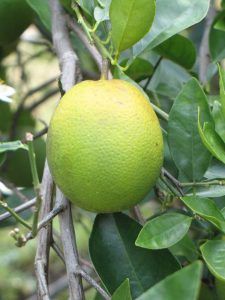
That insect’s posterior is up in the air! How unusual, is it smelling the orange stem?
Its evil red eyes indicate trouble. Yes, the insect is the Asian citrus psyllid (ACP) and it has been causing trouble for years in the citrus fields and on your backyard citrus trees. Its rump is up in the air as it feeds on the tender new leaves and stems. The ACP is responsible for spreading the citrus greening disease in Florida. When an infected psyllid feeds on the citrus trees, the bacteria in their digestive juices is transmitted into the tree’s sap and then into the phloem.
Solutions and alternative fruit tree options?
All citrus cultivars can be infected by the psyllid. The trees will go into decline shortly after inoculation. The maturity of the tree, the planting site, and the cultural practices of watering and fertilizing have effects on the rate of decline. The most impacted trees are the younger ones and those neglected. Infected younger trees may not go into fruit production.
Once a tree is infected with the citrus greening, there isn’t a cure. The disease affects the vascular system of the tree. The phloem is the part of the tree that carries carbohydrates from the leaves to the rest of the tree. The psyllids feed on the tender new growth leaving behind notches on the leaf’s edge. One of the best defenses is to take preventive measures during the new growth periods.


What are the symptoms of citrus greening?
Unfortunately, different citrus cultivars express different symptoms. Keep in mind that once you confirm the symptoms for citrus greening, it is too late to cure the plant. Some symptoms to look for:
- Blotchy appearance or yellowing starts on one branch then spreads throughout the tree;
- blotchiness or mottling on one side of the leaf midrib but not on the other side of the midrib;
- fruit can be smaller or fruit production decreases;
- twig dieback;
- fruit when sliced open can be misshapen or have aborted seeds, OR
- the outer skin can have uneven yellowing where the bottom of the fruit is green and the top of the fruit is yellow.
Singly, these symptoms can mimic cultural or nutritional problems. If you are unsure of the health of your tree, please bring in a leafy branch (about a one-foot section from the branch tip) and fruit sample into the Manatee County Extension Office Plant Diagnostic Clinic opened weekdays, except Wednesday, from 9 am to 4 pm.
What can a homeowner do?
The best advice – keep your trees strong and healthy by exercising proper cultural practices of fertilization, watering, and proper planting site (full sun and well-draining.) The psyllid is difficult to control.
- Scout (look at the leaves on top and bottom) on a regular (weekly) basis for the insect and its feeding damage during new growth periods.
- Citrus trees can be sprayed with specific active ingredients for the Asian citrus psyllid.
- Chose soil applications when possible and use a combination of active ingredients.
- Rotate the active ingredients to prevent pesticide resistance: imidacloprid, fenpropathrin, chlorpyrifos, or petroleum oil for nymph control.
- It is important to remove the tree once you have confirmed citrus greening. The tree is a future source for the psyllid to spread the disease to the next disease-free tree.
Lastly, consider diversity and plant other fruit tree choices for Manatee County. The County Extension Office provides publications on approximately 20 alternative fruit trees like Barbados cherry, jackfruit, jaboticaba, lychee, pomegranate, low-chill peaches, grapes, and more. It is important to plant a diversity of tree types to prevent diseases from wiping out all your fruit trees.
Good news! Many insects, parasitic wasps, syrphid flies, and lady beetles, successfully control the psyllids. However, the biological-controlling insects cannot keep up with the psyllid populations.
For additional information on the proper cultural practices for citrus trees, please contact the extension office. Visit http://manatee.ifas.ufl.edu/lawn_and_garden/master-gardener/gardening-manatee-style/c/citrus-monthly-care-calendar.pdf for care and fertilizer information and http://edis.ifas.ufl.edu/topic_asian_citrus_psyllid for psyllid information.
 1
1
